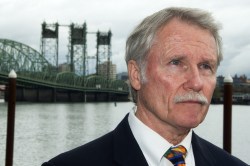
Oregon Department of TransportationOregon Gov. John Kitzhaber likes to look at the big picture.
Keystone is getting all the attention, but the brewing battle over coal exports in the Pacific Northwest is, from a pure carbon standpoint, far more significant. Right now one of the main problems for climate hawks is that all the decisions about new coal trains and coal export terminals are being made locally, one at a time, as rail and coal companies bribe this town and that town with promises of economic development. There’s no global assessment being done and no real plan in place.
The U.S. Army Corps of Engineers has refused thus far to do a comprehensive assessment, which is absurd — something to rally behind after the Keystone thing is resolved, perhaps. But most of the real authority lies in the hands of state lawmakers. So climate hawks have been watching new Washington Gov. Jay Inslee (D) and Oregon Gov. John Kitzhaber (D) like, um, hawks.
Kitzhaber, who has called for a federal review of coal ports before, had some interesting things to say yesterday at a summit of the American Wind Energy Association. Here’s a short clip:
It’s great to hear this kind of informed skepticism about coal ports. But beyond that, Kitzhaber is deploying one of the most crucial weapons of the climate hawk: perspective.
The closer in you get on a given decision, the more you exclude large-scale and long-term questions, the more able you are to justify the one-after-another little decisions that lock us into a disastrous carbon trajectory. This one little town will get this one chunk of money if they allow this one coal rail track through. It’s hard, in that town, facing that decision, to resist.
To have a basis for resisting, you have to pull the camera back. What’s the environmental effect of dozens of new trains and ports? What’s the effect on the region’s long-term economic development? What’s the effect on climate emissions? What’s the plan, the bigger picture, into which this little decision is supposed to fit?
Decisions that make sense in the micro often don’t in the macro. (Like Keystone!) So that’s what Kitzhaber is trying to do: pull the camera back. He’s asking whether we want to stumble into all this new coal-export infrastructure with no national energy plan and no sense of how it will affect emissions or prices.
It’s a good question.



